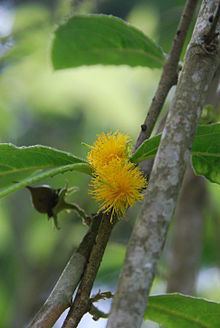Kingdom Plantae Family Salicaceae Scientific name Banara vanderbiltii Rank Species | Order Malpighiales Genus Banara Higher classification Banara | |
 | ||
People also search for Micropholis polita, Casearia crassinervis | ||
Banara vanderbiltii is a rare species of plant in the willow family known by the common name palo de ramon. It is endemic to Puerto Rico, where there are fewer than 20 known individuals left in the wild. At the time it was listed as an endangered species of the United States in 1987, there were only six plants remaining.
This is an evergreen shrub which can grow up to 9 meters tall, bearing rough-textured hairy leaves up to 12 centimeters long by 4 wide. The flowers are yellow and have many stamens. The red-purple fruits provide food for birds, including the bananaquit (Coereba flaveola) and the western spindalis (Spindalis zena).
The shrub grows in moist forests on limestone substrates. Its habitat has been subject to deforestation, the main cause of its rarity. Land is cleared for agriculture, including coffee plantations, and livestock are grazed in the area. Military exercises have also occurred nearby, with sections of the forest being trampled.
The plant was known to occur near San Juan long ago, but these occurrences have long since been extirpated by urban development. It now occurs only in one area along the northwestern coast, with one tiny population located near Cayey and a second, smaller one near Bayamón.
The plant was discovered in 1899 and named for Cornelius Vanderbilt, who financed plant-collecting expeditions.
